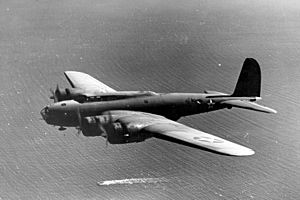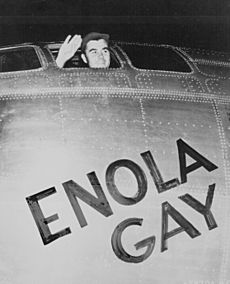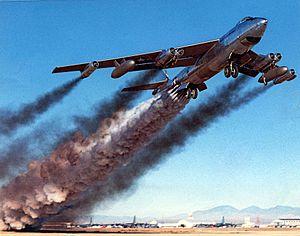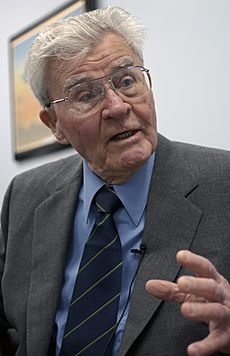Paul Tibbets facts for kids
Quick facts for kids
Paul Tibbets
|
|
|---|---|
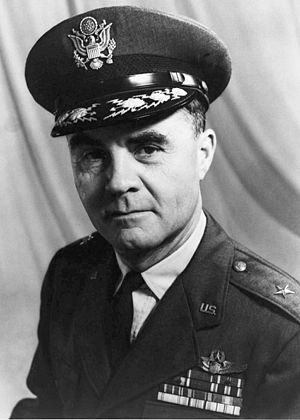
Tibbets c. 1960
|
|
| Birth name | Paul Warfield Tibbets Jr. |
| Born | 23 February 1915 Quincy, Illinois, U.S. |
| Died | 1 November 2007 (aged 92) Columbus, Ohio, U.S. |
| Allegiance | |
| Service/ |
|
| Years of service | 1937–1966 |
| Rank | Brigadier general |
| Commands held | 340th Bombardment Squadron 509th Composite Group 308th Bombardment Wing 6th Air Division |
| Battles/wars | World War II:
|
| Awards | Distinguished Service Cross Legion of Merit Distinguished Flying Cross (2) Purple Heart Air Medal (4) |
| Alma mater | University of Florida |
| Other work | Charter Pilot and President of Executive Jet Aviation |
Paul Warfield Tibbets Jr. (born February 23, 1915 – died November 1, 2007) was a high-ranking officer, a brigadier general, in the United States Air Force. He is most famous for being the pilot of the Enola Gay, a B-29 Superfortress airplane. This plane dropped the "Little Boy" atomic bomb on the Japanese city of Hiroshima during World War II. It was the first time an atomic bomb was used in warfare.
Tibbets joined the United States Army in 1937 and became a pilot in 1938. After the attack on Pearl Harbor, he flew patrols over the Atlantic Ocean. In 1942, he led the 340th Bombardment Squadron, which flew B-17 bombers. His group was the first to be sent to England as part of the Eighth Air Force. He led the first American daylight bombing mission in Europe in August 1942. He also led the first American raid with over 100 bombers in Europe in October 1942.
Tibbets returned to the United States in 1943 to help develop the Boeing B-29 Superfortress. In 1944, he was chosen to lead the 509th Composite Group. This secret group was formed to carry out the atomic bombings of Hiroshima and Nagasaki. After the war, he helped with nuclear weapon tests and the development of new jet planes. He retired from the Air Force in 1966 and later became the president of an aviation company.
Contents
Becoming a Pilot
Paul Warfield Tibbets Jr. was born in Quincy, Illinois, on February 23, 1915. His mother's name was Enola Gay Tibbets. When he was young, his family moved several times. Paul became very interested in flying.
When he was 12, he flew in a plane with a pilot named Doug Davis. They dropped candy bars with tiny parachutes to people watching races! This experience likely made him love flying even more.
Paul first planned to become a surgeon. He studied at the University of Florida and the University of Cincinnati. But he changed his mind and decided to join the United States Army to become a pilot instead.
Joining the Army Air Corps
Because Paul had some college education and flight experience, he qualified for a special pilot training program. In 1937, he joined the army. He went to Randolph Field in San Antonio, Texas, for flight training. He proved to be a very good pilot. In 1938, he became a second lieutenant and earned his pilot wings.
After his training, Tibbets was sent to Lawson Field, Georgia. Here, he met Lucy Frances Wingate and they got married in 1938. They had two sons, Paul III and Gene.
In 1940 and 1941, Tibbets was a personal pilot for Brigadier General George S. Patton, Jr.. In 1941, he moved to Hunter Field, Savannah, Georgia. He was promoted to captain. In December 1941, he was ordered to train on the Boeing B-17 Flying Fortress. On December 7, 1941, he heard about the Japanese attack on Pearl Harbor while flying.
Fighting in Europe
In February 1942, Tibbets joined the 29th Bombardment Group. Soon after, he became the leader of the 340th Bombardment Squadron. This squadron flew B-17D bombers.
In July 1942, Tibbets's group was sent to England. They were the first heavy bomber group from the Eighth Air Force to go there. They quickly trained for their first mission. Tibbets became the deputy commander of the group.
On August 17, 1942, Tibbets flew the lead bomber for the first American daylight bombing mission. They attacked a train yard in Rouen, Occupied France. On October 9, 1942, Tibbets led the first American raid in Europe with over 100 bombers. They attacked factories in Lille, France. Even though some bombs missed their targets, the mission was seen as a success because they reached their goal despite strong enemy attacks.
During these missions, Tibbets saw bombs hitting civilians. He thought about how innocent people were being killed. He remembered a lesson from medical school: doctors needed to put feelings aside to do what was necessary. This helped him focus on his duty.
Important Flights
Before the Allied invasion of North Africa (called Operation Torch), Tibbets was chosen for a secret mission. He flew Major General Mark W. Clark to Gibraltar. A few weeks later, he flew the top Allied commander, Lieutenant General Dwight D. Eisenhower, there too. Historians said Tibbets was "the best flier in the Army Air Force."
Tibbets flew 25 missions in France. Then, his group moved to North Africa. He saw the harsh realities of war, including losing friends. By January 1943, he had flown 43 combat missions. He was then assigned to help plan bomber operations.
The Secret Mission
General Henry H. "Hap" Arnold, the head of the Army Air Forces, needed an experienced pilot to help develop the new Boeing B-29 Superfortress bomber. Tibbets was recommended and returned to the United States in February 1943. The B-29 program had many problems, and its chief test pilot had died in a crash.
Tibbets worked with the Boeing factory in Wichita, Kansas. He test-flew the B-29 more than any other pilot. He found that without heavy weapons, the plane was much lighter and flew better. He even found that the B-29 could out-turn a P-47 fighter plane at high altitudes.
In September 1944, Tibbets was put in charge of the 509th Composite Group. This was a special, secret group of about 1,800 men with 15 B-29s. Their mission was to drop the atomic bomb. Tibbets chose Wendover Army Air Field in Utah for their base because it was very remote.
Tibbets was promoted to colonel in January 1945. He allowed married men in his group to bring their families to the base to boost morale. However, he had to keep the secret of the atomic bomb from everyone, including his wife. He even told her the scientists working on the project were "sanitary workers."
Preparing for the Bombing
In March 1945, a special squadron was created to help the 509th Group. Their job was to assemble the atomic bombs at the operating base. Only the best people were chosen for this, with 80% of applicants being turned away. By May 1945, the 509th Composite Group was fully ready.
Most of the group moved to Tinian, an island close enough to Japan for bombing missions. They were joined by scientists and military leaders from the Manhattan Project, the secret project that built the atomic bomb.
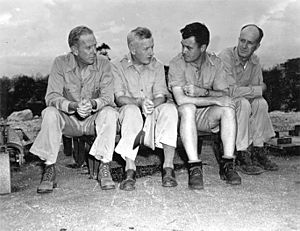
On August 5, 1945, Tibbets officially named his B-29 airplane Enola Gay, after his mother. He had personally chosen this plane while it was still being built. The plane's usual pilot, Robert A. Lewis, was upset that Tibbets would fly this important mission. Lewis flew as Tibbets's co-pilot instead.
At 2:45 AM the next day, August 6, 1945, the Enola Gay took off from Tinian for Hiroshima, Japan. Tinian was about 2,000 miles (3,200 km) from Japan, so the flight took six hours. The atomic bomb, called "Little Boy," was dropped over Hiroshima at 8:15 AM local time. Tibbets remembered seeing a huge mushroom cloud after the bomb exploded.
After the Mission

After landing back on Tinian, Tibbets received the Distinguished Service Cross award. He became a national hero, seen as the person who helped end the war with Japan. He was even invited to visit President Harry S. Truman at the White House.
In interviews, Tibbets often said he was proud of his role. He stated, "I sleep clearly every night." He knew the mission would cause many deaths, but his main goal was to end the war as quickly as possible to save more lives overall.
After the War
The 509th Composite Group returned to the United States in November 1945. Tibbets later became a technical advisor for nuclear tests in 1946.
He continued his military education and worked at the Pentagon. He believed that future bombers would be jet aircraft. He became involved in the development of the Boeing B-47 Stratojet jet bomber in the early 1950s. He then led flight testing for the B-47.
In 1955, Tibbets became the Director of War Plans for Allied Air Forces in Central Europe, based in France. He later commanded the 308th Bombardment Wing and the 6th Air Division. He was promoted to brigadier general in 1959. From 1964 to 1966, he served as a military advisor in India. He retired from the United States Air Force on August 31, 1966.
Later Years and Legacy
After leaving the Air Force, Tibbets worked for Executive Jet Aviation, a company that provides private jet services. He was one of the first board members and later became its president from 1976 until 1986. He fully retired in 1987.
Paul Tibbets's grandson, Paul W. Tibbets IV, also became a pilot in the Air Force. In 2006, he became the commander of the 393d Bomb Squadron. This squadron was part of his grandfather's original 509th Composite Group. Paul Tibbets IV was promoted to brigadier general in 2014 and later commanded the 509th Bomb Wing.
Paul Tibbets Jr. passed away at his home in Columbus, Ohio, on November 1, 2007, at the age of 92. He had been ill for some time. He asked for no funeral or headstone. He feared that people who disagreed with the bombing might damage his grave. So, his body was cremated, and his ashes were scattered over the English Channel, a place he flew over many times during the war.
Awards and Decorations
 |
||
| USAF Command pilot badge | ||
| Distinguished Service Cross | ||
| Legion of Merit | Distinguished Flying Cross with bronze oak leaf cluster |
Purple Heart |
| Air Medal with three bronze oak leaf clusters |
Joint Service Commendation Medal | Army Commendation Medal |
| Air Force Outstanding Unit Award with Valor device and bronze oak leaf cluster |
American Defense Service Medal | American Campaign Medal |
| European-African-Middle Eastern Campaign Medal with three bronze campaign stars |
Asiatic-Pacific Campaign Medal with two bronze campaign stars |
World War II Victory Medal |
| National Defense Service Medal with bronze service star |
Air Force Longevity Service Award with silver and bronze oak leaf clusters |
Small Arms Expert Marksmanship Ribbon |
Source: Ohio History Central.
See also
 In Spanish: Paul Tibbets para niños
In Spanish: Paul Tibbets para niños


